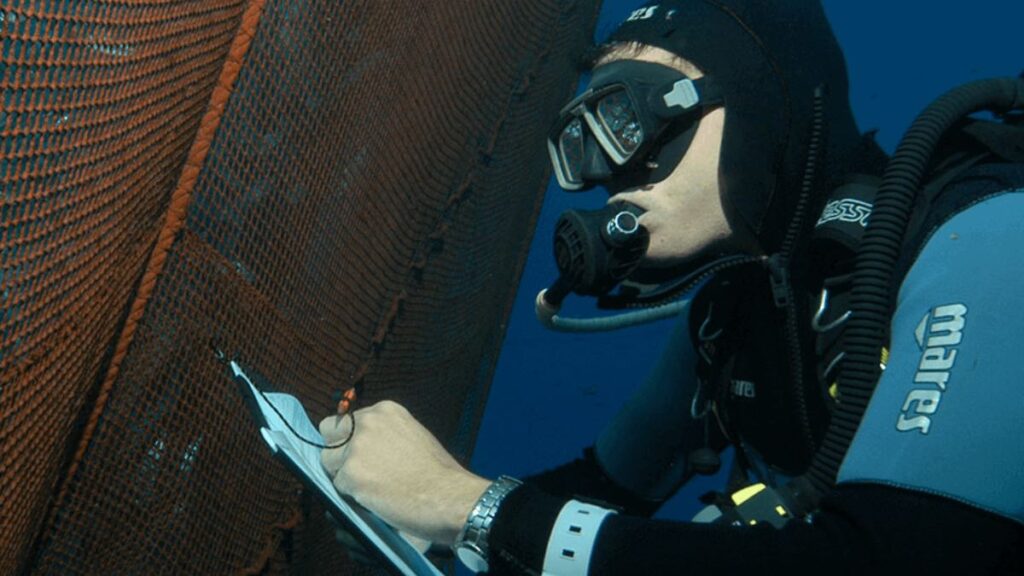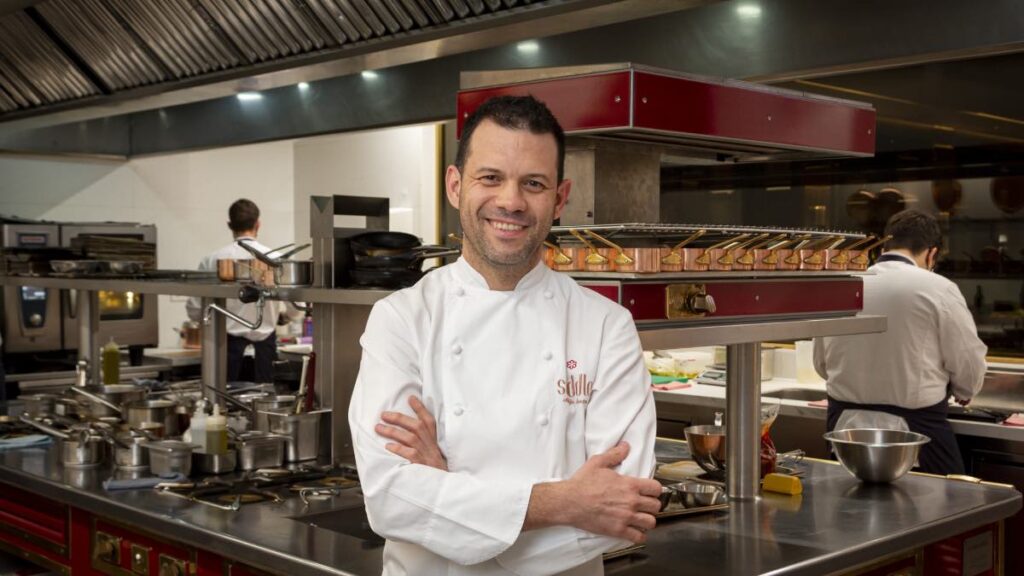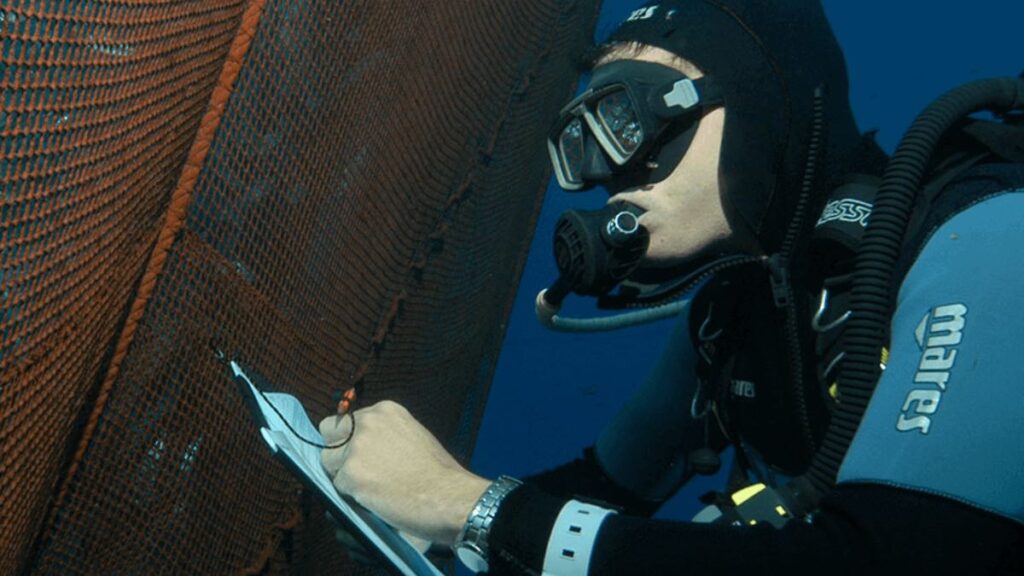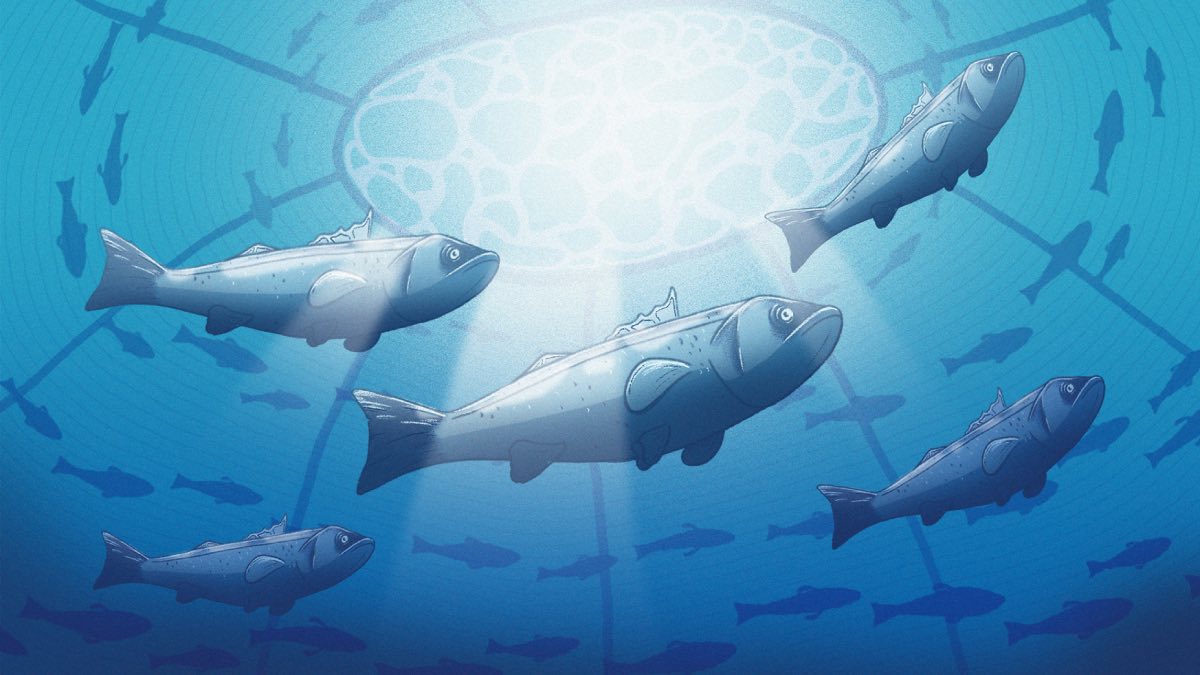Click here to read the Spanish version.
Where does the pineapple lie beneath the sea, perhaps in the fact that fresh fish is valued because it comes from here, from the Spanish coast? In traceability, in sustainability? Delving deeper into the question and, as happens on land with fruit and vegetables, another issue arises, that of respecting the season. This is a journey that sets off from the sea, from the Levante, under the Crianza de Nuestros Mares label, arrives in Spain’s main port, which is none other than the Madrid plateau, and moors in the Canary Islands.
“More than 95% of the sea bass and sea bream we consume in the market are from aquaculture, coming from a controlled environment,” says Garazi Rodríguez, head of production and marketing plans at Apromar, the Spanish Aquaculture Business Association, a non-profit professional organisation with national scope and recognised by the European Union. “Our aim is to promote sustainable aquaculture,” Garazi stresses. And we achieve this under the Crianza de Nuestros Mares seal, a seal that guarantees the origin and freshness, quality and food safety of our sea bass, sea bream and sea bass. In fact, since 2021 our motto has been “If you like fresh, choose ours”.
One of the settings for Crianza de Nuestros Mares is Burriana, Castellón, where Avramar is one of the four companies behind the label, together with Aquanaria, Geremar and Piscialba. “A large part of the national production of sea bream, sea bass and sea bass is represented by Crianza de Nuestros Mares”, they say at the port. In Burriana, the seal is committed to this origin, to the consumption of fresh fish from here, from the Spanish coast. “In addition, another of the advantages of eating fish from the nursery is that the level of Omega 3 and Omega 6 is ten times higher than that of wild fish. And that stays in the flesh,” says Eduardo Soler, head of sustainability at Avramar. “In aquaculture we are feeding our species constantly all year round and we are committed to sustainable aquaculture, reflected for example in the ample space for the fish in the hatchery, where 95% is water. In fact, at Crianza de Nuestros Mares we generate the lowest carbon footprint in responsible aquaculture. Bureau Veritas certifies this every month in terms of water and bottom quality.

“One of the main enemies of fresh fish from aquaculture is fish imported from Greece, Turkey and Ecuador, which accounts for around 70% of the fish imported into Spain. Aware of the market share generated by aquaculture, the European Union already sees this sector as a parallel route to extractive fishing. “We have gone from being fishermen to fish farmers,” they conclude.
But what do our chefs think? We spoke to Carlos Urrutikoetxea, from El Señor Martín. “For me there is no debate between fresh fish and aquaculture. In fact, I think there should be more aquaculture with good practices that can supply good quality product on a large scale at a reasonable price, differentiating it from artisanal fishermen. Aquaculture is necessary, I prefer it to fish farming, but both are valid because society needs to be fed. But I do believe that fishing gear of all kinds should be more respectful of the sea and pay what it costs, differentiating it from the swimming pool. And that’s it. What is not acceptable is to go to the fishmonger’s and be sold sea bass for good sea bass”.
“Fresh fish or aquaculture? What there should be is more aquaculture with good practices and supplying quality product at reasonable prices…”.
Carlos Urrutikoetxea
Mr Martin speaks. “The important thing is not to fish in a devastating way. Whoever I buy turbot from, the sets he makes (when he throws the net into the water) are three or four hours. Usually, a guy sets the net, goes away, comes back the next day and catches the turbot, which has been suffering for a day. However, if you do like this guy I’m telling you, you have practically freshly caught turbot. He goes ashore, cuts them in the gill and they die. That costs a lot of money, so we can’t expect to feed the planet with wild turbot, so I understand why aquaculture and fish farming exist.
Today Carlos bought two sea bream, four viceroys, a sea bass, a John Dory and three red mullet. Selection by the bucketload. “I understand that if you are a big business and you need to sell a hundred fish, that’s where the selection stops. In my case, I am lucky enough to work for a small client and, on the other hand, to go for specific buyers in good auctions and independent fishermen. This is our defence of wild fish: traceability, traceability”. Carlos takes a scallop from Oleron, an island off Arcachon. “Sebastien and Natalie, who live on the island, bring them to me; they come down on Mondays, and they also take me oysters that are really refined. When they tell me ‘I have an oyster or a scallop I want you to try’, I buy it from them. Otherwise, I don’t even touch it.
What about sustainability? “Within this, my struggle is to work for the fishermen to be paid what they should be paid. Another issue that comes up is the season. “Bivalves such as clams or cockles are perhaps better in December, because the water is colder, and with the first squalls the bottom begins to move, and that means the fish has more nutrients. His dish of pocha beans with clams is proof of this. “We have come to the conclusion that fresh or not fresh fish is not a question of whether it is one day old or two. The sea bass I served today was a week old, and, in fact, if it had had a few more days to relax that stiffness, all the better. Rigor mortis has to be very high because that means that it has died a good death”.
Here comes the dish of the day, another of Carlos’ mantras. Sea bass belly and parpatana. The flank, the mormo… here everything is used. “I know of very few good restaurants where they give you the head of the fish, the belly and the fin. What was the fish born for, for you to waste it? With a wisdom that he tries to hide behind the bar, Carlos Urrutikoetxea encourages people to get to know his small seafood larder, when it comes to checking the freshness. “I pay a lot of attention to ensure that each piece has a whole globe, because in a fishmonger’s, for example, they are inside out. I also check that the gills are red. Maybe it would be good if the grandmothers who cook at home went to schools to teach all this, more than anything else as a social task”.
“Perhaps grandmothers should be brought into schools to teach them to distinguish good fish from bad, and fishermen to teach them to respect the sea.
Adolfo Santos
Adolfo Santos, the brains and heart of Saddle, also begins with this headline. “Everyone has to know where they want to be. We are committed to wild fish. Aquaculture has been working and researching for many years to improve, but, in my opinion, it has nothing to do with whether this is the solution to the problem of sustainability and the ever-increasing demand for fish in the world”.

Adolfo Santos’ position: be responsible when it comes to consumption. “Let sea bream be eaten not only on Christmas Eve, but also in January or November”. Of course, each fish should be linked to the season in which it will always be good. Maybe we should take fishermen to schools to really respect the sea”. And as in the case of Carlos, Adolfo also defends the selection of specific artisans. “There are fewer and fewer people working in small-scale fishing, in the face of greater demand. For example, I work with Roberto, from Artesáns Da Pesca and he always says we are what we eat, but we are what others eat. For me, if we compare one and the other way of consuming fish, I think of that wild sea bass, which is on the rocks of a cliff, eating crabs and comes by the currents and which in season has a fat or roe”.
Adolfo Santos also points to the lack of information, including from fishmongers. “Where does the fish come from? Who catches it? You don’t find out about this at the fishmonger’s, they don’t give you the right information and we often don’t take an interest in it either. On the other hand, most fish markets discard quality fish such as mackerel, as opposed to turbot. Then it goes to companies that go for a price. Among Saddle’s artisanal fishermen, there is also Alberto Monzón from DELAMAR, for large pieces of fish over three kilos. “Because another thing is to try not to deplete the sea. I, for example, have five fish on my menu, but if they tell me there is no fish in one place, I don’t go looking for it in another. Let’s fight for the authenticity of things.
“I identify each piece when I see the eye, the gill, when I feel the rigidity, when I open it and see what’s inside…”.
Alberto Monzón
Saddle also has a mini-point for the use made of it. “When I make my scandals for each menu, I think of those 90 grams of fish loin I put in, bone and all. Let’s be honest, let’s make the most of every piece, let’s not just put the fin and throw the rest of the fish away. A luxury place has to offer real luxury”. Another goal: to know your fish. “I’ve been to fine-dining restaurants that buy the clean fish directly. And there I ask myself: how can you serve something you haven’t seen? I identify each piece when I see the eye, the gill, when I feel the rigidity, when I open it and see what’s inside and what it has eaten…. It’s ethics, principles. Let’s eat wisely”.
We fly to the University of Las Palmas de Gran Canaria. Doctor José Juan Castro Hernández, oceanographer and director of the Biology Department of this institution, talks to Tapas. “I don’t think there is a debate between aquaculture and wild fishing, if we focus on the industrial activity itself. They are different economic environments, but the Maritime Fisheries Act brings them together. And the medium, water. On the issue of food: Dr Castro Hernández does not see any conflict in the fact that, faced with an ever-decreasing consumption of meat, the alternative is fish. “The problem is not in consuming fish versus rice, but in using less harmful techniques. He cites one of what he sees as one of the most serious problems in our depleted seas: discarding. “According to the studies consulted, between 8 and 30%, approximately, of the fish catch is lost. It’s not fishing, but bad fishing, which doesn’t care about the sizes, the species, or the fact that to catch a kilo of prawns you have to kill ninety small fish”.

There is another overwhelming fact. “Some studies already point to the year 2049 as the date when we will have more plastic than fish in the sea, and not because there will be a lot more plastic… but a lot less fish. Involvement: of fishermen and administrations. “They are the ones who can make decisions for a future that is already today; what happens is that they often legislate without being aware of what is happening in the environment. It is also necessary to train more than one scientist, who do not have a clear awareness, in these cases, of the dimension of the problem”. Get out of the office. Society as a whole must get involved. “The Galician shellfish gatherers have already done so. Also the chefs. “As the final link in the product, they can ensure sustainability, in addition to conditioning the fishermen to get involved in this. And by involving them, they will be involving the administration”.
The doctor is categorical. “Aquaculture, at the moment, I don’t think it is an alternative to wild fishing. A large part of the feed for fish in the former comes from other fish, so there is a clear dependence of aquaculture on extractive fishing here, because fish in hatcheries are fed on feed made from fishmeal and other fish by-products. At the end of the day, we are turning cheap fish into expensive fish. It is turning lead into gold and, in this sense, it puts a further strain on fisheries.
But aquaculture for tomorrow, maybe yes, according to the doctor. The debate is beginning to transcend fishing techniques themselves. “It’s a question of overfishing in the whole system. However, the marine system has an enormous capacity to respond. Everything recovers quickly. It won’t be the same as it was 50 years ago, but we will achieve an optimal balance. So let’s fight for our seas. With love.
Illustration by Silvia G. Machicado.

